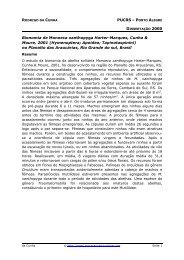Hydrologie - dezentraler Hochwasserschutz
Hydrologie - dezentraler Hochwasserschutz
Hydrologie - dezentraler Hochwasserschutz
Erfolgreiche ePaper selbst erstellen
Machen Sie aus Ihren PDF Publikationen ein blätterbares Flipbook mit unserer einzigartigen Google optimierten e-Paper Software.
LIU, CH.-M. (1987): Source of increasing stormwaters after forest operations. Forest hydrology and<br />
watershed management, IAHS 167, 539-544.<br />
LUCE, C. H. & T. A. BLACK (1999): Sediment production from forest roads in western Oregon. WRR<br />
35(8), 2561-2570.<br />
LUCE, C. H. (2002): Hydrological pocesses and pathways affected by forest roads: what do we still<br />
need to learn? Hydrological Processes 16, 2901-2904.<br />
LUDWIG, K. (1969): Oberflächenabfluß, Bodenerosion und vorbeugender <strong>Hochwasserschutz</strong>. WWT<br />
19(Heft 4), 130-134.<br />
LUIG, A. (2003): Aufbau eines GIS-gestützten Waldwegeinformationssystems am Beispiel des<br />
Rammerts, Stadtwald Rottenburg. Fachhochschule Rottenburg - Hochschule für Forstwirtschaft,<br />
Diplomarbeit, 78 S. + Anhang.<br />
LULL, H. W. & K. G. REINHART (1972): Forests and floods in the Eastern United States. USDA<br />
Forest Service, Research Paper NE-226, 94 S.<br />
LYNCH, J. A. & E. S. CORBETT (1982): Increasing summer storm peakflows following progressive<br />
forest clearcutting. Canadian Hydrology Symposium 82, Fredericton, New Brunswick, 561-574.<br />
MACKAY, D. S. & L. E. BAND (1997): Forest ecosystem processes at the watershed scale: Dynamic<br />
coupling of distributed hydrology and canopy growth. Distributed hydrological modelling -<br />
Applications of the TOPMODEL concept, 85-105.<br />
MAGIERA, P., W. WEINZIERL & CH. LEIBUNDGUT (1998): Flächenversiegelung und<br />
Wasserkreislauf - der Einfluß des Naturraumes auf die Versickerung von Regenwasser. Wasser &<br />
Boden 50(4), 32-36.<br />
MAIERHOFER, F. (1988): Erkenntnisse und Erfahrungen über die Wasserableitung nach 4<br />
Jahrzehnten Forststraßenbau. INTERPRAEVENT, Band II, 61-71.<br />
MANABE, S., P. C. D. MILLY & R. WETHERALD (2004): Simulated long-term changes in river<br />
discharge and soil moisture due to global warming. Hydrological Sciences - Journal 49(4), 625-642.<br />
MARC, V., J. - F. DIDON - LESCOT & C. MICHAEL (2001): Investigation of the hydrological<br />
processes using chemical and isotopic tracers in a small mediterranian forested catchment during<br />
autumn recharge. Journal of Hydrology 247, 215-229.<br />
MARENBACH, B. (2002): Der Beitrag naturnaher Retentionsmaßnahmen in den Talauen zur<br />
Hochwasserdämpfung. Fachgebiet Wasserbau und Wasserwirtschaft der Universität<br />
Kaiserslautern, Berichte 13, 183 S.<br />
MASUCH, K. (1961): Über Wechselbeziehungen zwischen Hochwasser und Bodennutzung. Gerlands<br />
Beiträge zur Geophysik 70(4), 233-254.<br />
MATTHIES, D., H. WEIXLER & U. HESS (1995): Befahrungsbedingte Strukturveränderungen von<br />
Waldböden. Allgemeine Forstzeitschrift 50(22), 1218-1221.<br />
MAURER, TH. (1997): Physikalisch begründete, zeitkontinuierliche Modellierung des<br />
Wassertransports in kleinen ländlichen Einzugsgebieten. Karlsruhe, IHW der Universität Karlsruhe,<br />
Mitteilung 61, 212 S. + Anhang (Grundlagen und Daten).<br />
MAUSER, W. (1985): Prognose von Hochwässern mit LANDSAT-Daten. Freiburg, Verlag Beiträge zur<br />
<strong>Hydrologie</strong>, 245 S.<br />
MAZUREK, T. & T. WEGOREK (1987): Influence of the catchment area utilization on erosion<br />
processes reinforced gullies. Roczniki Gleboznawcze T. 38(1), 199-208.<br />
MCGLYNN, B. L., J. J. MCDONNEL & D. D. BRAMMER (2002): A review of the evolving perceptual<br />
model of hillslope flowpaths at the Maimai catchments, New Zealand. Journal of Hydrology 257, 1-<br />
26.<br />
MCGLYNN, B. L. & J. J. MCDONNEL (2003): Quantifying the relative contributions of riparian and<br />
hillslope zones to catchment runoff. WRR 39(11), SWC 2-1 - 2-20.<br />
MCGUIRE, K. J., J. J. MCDONNELL, M. WEILER, C. KENDALL, B. L. MCGLYNN, J. M. WELKER &<br />
J. SEIBERT (2005): The role of topography on catchment-scale water residence time. WRR 41(5),<br />
W05002, 1-14.<br />
MEGAHAN, W. F. (1972): Subsurface flow interception by a logging road in mountains of Central<br />
Idaho. National Symposium on Watersheds in Transition, Fort Collins/Color., 350-356.<br />
MEGAHAN, W. F. & J. L. CLAYTON (1983): Tracing subsurface flow on roadcuts on steep, forested<br />
slopes. Soil Sci. Soc. Am. Journal 47(6), 1063-1067.<br />
MEGAHAN, W. F. (1987): Effects of forest roads on watershed function in mountaneous areas.<br />
Environmental Geotechnics and Problematic Soils and Rocks, Balkema/Rotterdam, 335-348.<br />
MEHLHORN, J. (1998): Tracerhydrologische Ansätze in der Niederschlags-Abfluß-Modellierung.<br />
Institut für <strong>Hydrologie</strong> der Universität Freiburg/Br., C. Leibundgut & S. Uhlenbrook, Freiburger<br />
Schriften zur <strong>Hydrologie</strong>, Band 8, 148 S.<br />
MENDEL, H.-G. (2000): Elemente des Wasserkreislaufs - Eine kommentierte Bibliographie zur<br />
Abflußbildung. Bundesanstalt für Gewässerkunde und Analytica Verlag, 248 S.<br />
44



